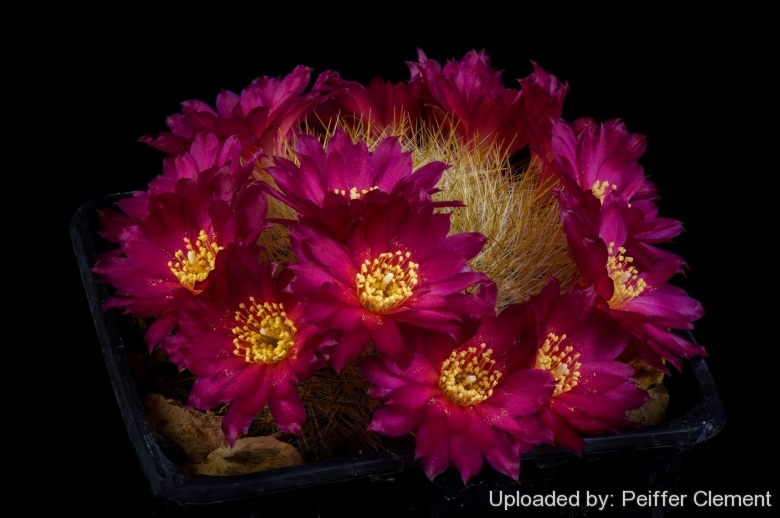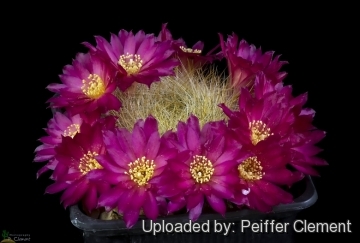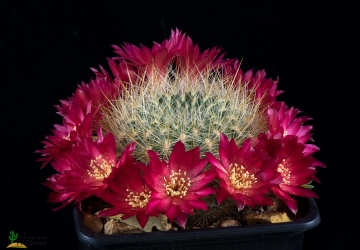Accepted Scientific Name: Rebutia mentosa (F.Ritter) Donald
Bradleya 5: 93. 1987

Sulcorebutia cupreata Photo by: Peiffer Clement
Origin and Habitat: Aiquile, Cochabamba, Bolivia (Field number KK1800).
Altitude range: 3000 metres above sea level.
Synonyms:
See all synonyms of Rebutia mentosa
back
Accepted name in llifle Database:Rebutia mentosa (F.Ritter) DonaldBradleya 5: 93. 1987Synonymy: 32
Accepted name in llifle Database:Rebutia mentosa subs. purpurea (Donald & A.B.Lau) Donald ex D.R.HuntCactaceae Consensus Init. 3: 6. 1997Synonymy: 4
back
Description: Sulcorebutia cupreataSN|34230]]SN|34230]] is an undescribed name (nomen nudum - Abbreviation n. n. A title lacking valid description). It was first named by the Czech cactus trader Karel Knize, resident in Lima, Peru. It has been said that Knize gave most of the plants he collected/sold new names to increase sales. Knize never properly described his plants, he just gave them names and sold them. He deliberately hunted down unusual looking things so it can be difficult to characterise them in terms of the existing described species. This “species” is somewhat similar to Sulcorebutia flavissimaSN|15374]]SN|15369]] (Rebutia mentosa), but Rod and Ken Preston-Mafham, in their “Cacti: The Illustrated Dictionary” lists Sulcorebutia flavissimaSN|15369]]SN|15369]] Rausch as an alternative name for Weingartia flavidaSN|15373]]SN|15373]] F.H.Brandt, Sulcorebutia flavidaSN|15369]]SN|15374]] (F.H.Brandt) Pilbeam and Sulcorebutia cupreataSN|34230]]SN|34230]] n.n. (Kníže ), but then who can say what it should really look like since Knize never described it.
Derivation of specific name. Latin “Cupreatus,-a,-um” - copper coloured, possibly for the body colour?
Stem: Green.
Areoles: White to brownish, oval.
Radial spines: Protruding white to yellowish.
Flowers: Red-purple flower.
Central spines: Long straight yellowish to yellowish-brown.
Subspecies, varieties, forms and cultivars of plants belonging to the Rebutia mentosa group
 Rebutia mentosa (F.Ritter) Donald: (subsp. mentosa) has dark-brown or black spines; central spines 2-4. 5-8 mm long; radial spines 14-18 about 5 mm long.
Rebutia mentosa (F.Ritter) Donald: (subsp. mentosa) has dark-brown or black spines; central spines 2-4. 5-8 mm long; radial spines 14-18 about 5 mm long. Rebutia mentosa subs. purpurea (Donald & A.B.Lau) Donald ex D.R.Hunt: has dark-green to purplish stems, with a few less radials (10-17 about 4-8 mm long), but a few more central spines (2-5, 8 -12 mm long). Spines whitish-yellow to reddish-brown. Distribution: Aiquile to Santiago, Cochabamba.
Rebutia mentosa subs. purpurea (Donald & A.B.Lau) Donald ex D.R.Hunt: has dark-green to purplish stems, with a few less radials (10-17 about 4-8 mm long), but a few more central spines (2-5, 8 -12 mm long). Spines whitish-yellow to reddish-brown. Distribution: Aiquile to Santiago, Cochabamba. Sulcorebutia albissima (F.H.Brandt) Pilbeam: Spines off-white, greyish, to light brown, pectinately arranged, lying against the surface, flowers glossy purple. Distribution: Cochabamba.
Sulcorebutia albissima (F.H.Brandt) Pilbeam: Spines off-white, greyish, to light brown, pectinately arranged, lying against the surface, flowers glossy purple. Distribution: Cochabamba. Sulcorebutia albissima f. pectinifera hort.: has very tight white pectinate spines, and the spination of well-grown specimens is pleasing. Flowers bright purple. Distribution:Cochabamba (Aiquile to Mizque)
Sulcorebutia albissima f. pectinifera hort.: has very tight white pectinate spines, and the spination of well-grown specimens is pleasing. Flowers bright purple. Distribution:Cochabamba (Aiquile to Mizque) Sulcorebutia cupreata Kníže, n.n.: has protruding white to yellowish spines. Flowers Red-purple. Distribution: Aiquile, Cochabamba, Bolivia.
Sulcorebutia cupreata Kníže, n.n.: has protruding white to yellowish spines. Flowers Red-purple. Distribution: Aiquile, Cochabamba, Bolivia. Sulcorebutia flavissima Rausch: has bright yellow spines and purple-pink flowers with paler throat. Distribution: Orkho Abuelo foot and in the adjacent areas, between Aiquile and Mizque.
Sulcorebutia flavissima Rausch: has bright yellow spines and purple-pink flowers with paler throat. Distribution: Orkho Abuelo foot and in the adjacent areas, between Aiquile and Mizque.- Sulcorebutia formosa (F.H.Brandt) Pilbeam
 Sulcorebutia mairanana hort.: This controversial plant probably correspond to Sulcorebutia albissima (a white spined form of Rebutia mentosa). Distribution: Mairana in Bolivia.
Sulcorebutia mairanana hort.: This controversial plant probably correspond to Sulcorebutia albissima (a white spined form of Rebutia mentosa). Distribution: Mairana in Bolivia. Sulcorebutia santiaginiensis Rausch: very similar (if not the same) as Rebutia mentosa subs. purpurea but with somewhat weaker spines. Distribution: Aiquile to Santiago, Cochabamba.
Sulcorebutia santiaginiensis Rausch: very similar (if not the same) as Rebutia mentosa subs. purpurea but with somewhat weaker spines. Distribution: Aiquile to Santiago, Cochabamba. Sulcorebutia swobodae K.Augustin: has long soft, flexible spines, predominantly yellow but also brown to almost black. Distribution: Between Aiquile and Mizque, Cochabamba.
Sulcorebutia swobodae K.Augustin: has long soft, flexible spines, predominantly yellow but also brown to almost black. Distribution: Between Aiquile and Mizque, Cochabamba. Sulcorebutia torotorensis (Cárdenas) F.H.Brandt: it is very similar and referable (if not the same) to Rebutia mentosa subsp. purpurea. Distribution: Torotoro, Potosi, Bolivia.
Sulcorebutia torotorensis (Cárdenas) F.H.Brandt: it is very similar and referable (if not the same) to Rebutia mentosa subsp. purpurea. Distribution: Torotoro, Potosi, Bolivia.- Sulcorebutia unguispina Rausch
Bibliography: Major references and further lectures
1) Rod a Ken Preston-Mafham “Cacti: The Illustrated Dictionary”, 1997
 KK 1800 (Collector Karel) Locality: Aiquile, Bolivia, 3000m. Photo by: Peiffer Clement
KK 1800 (Collector Karel) Locality: Aiquile, Bolivia, 3000m. Photo by: Peiffer Clement - KK 1800 (Collector Karel) Locality: Aiquile, Bolivia, 3000m. Photo by: Peiffer Clement
- KK 1800 (Collector Karel) Locality: Aiquile, Bolivia, 3000m. Photo by: Peiffer ClementCultivation and Propagation: Sulcorebutias are summer grower species easy to cultivate, more cold tolerant than most. These mountainous plants have thick taproots and are susceptible to overwatering. They requires also an appropriate air circulation and are sometime grafted to avoid root problems.
Growth rate: It is a relatively rapidly growing and easily flowering species that will make clumps given the best conditions.
Soils: It likes very coarse mineral cactus mix soil, but can become too elongated if compost is too rich.
Repotting: Use pot with good drainage.
Watering: Water regularly from Spring to Autumn, but do not overwater(Rot prone), it must be strictly kept dry throughout the winter quiescent period since it is very sensitive to any moisture excesseskeep dry in winter.
Fertilization: Feed with a high potassium fertilizer in summer.
Hardiness: They need to be kept in a cool place during winter rest and are somewhat resistant to frost if kept on the dry side prior to, and during, cold weather (due to the altitude they are hardy to -7 C ° C, or less for short periods). The cold is important for the flowers, as well as for their health. Without this cool winter period, they normally won't get any buds.
Exposition: Requires full sun or light shade and careful watering to keep plant compact with strong coloured spines. Tends to bronze in strong light, which encourages flowering and heavy spine production. Light shadow my be useful in the hottest summer days.
Uses: It is an excellent plant for container growing. It always looks good and stays small. It look fine in a cold greenhouse and frame or outdoor in a rockery.
Pests & diseases: It may be attractive to a variety of insects, but plants in good condition should be nearly pest-free, particularly if they are grown in a mineral potting-mix, with good exposure and ventilation. Nonetheless, there are several pests to watch for:
- Red spiders: Red sopiders may be effectively rubbed up by watering the infested plants from above.
- Mealy bugs: Mealy bugs occasionally develop aerial into the new growth among the wool with disfiguring results, but the worst types develop underground on the roots and are invisible except by their effects.
- Sciara Flies: Sciara flies are one of the major problems for seedlings. It is a good practice to mulch your seedlings with a layer of grit, which will strongly discourage the flies.
- Scales: Scales are rarely a problem.
It is wise to treat your whole collection with a systemic insecticide twice a year in spring and autumn.
- Rot: Rot is only a minor problem with cacti if the plants are watered and “aired” correctly. If they are not, fungicides won't help all that much. To prevent rottenness it is also advisable to surround its root neck by very rough sand or grit, this help a fast water drainage.
Propagation: Seed, cutting, grafting. Seeds germinate in 7-14 days at 21-27° C in spring, remove gradually the glass cover as soon the plants will be well rooted (ca 1-2 weeks) and keep ventilated, no full sun for young plants!













